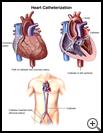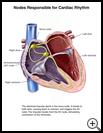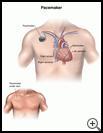
Temporary Cardiac Pacing
________________________________________________________________________
KEY POINTS
- Temporary cardiac pacing is the use of an electrical device called a pacemaker to help your heart beat regularly while you are in the hospital.
- Temporary pacing usually is done for just a few days. If your heart rhythm is not normal when the temporary pacemaker is shut off briefly, you will likely have surgery to place a permanent pacemaker.
- Ask your healthcare provider what risks apply to you. Be sure to discuss any questions or concerns that you may have.
________________________________________________________________________
What is temporary cardiac pacing?
Temporary cardiac pacing is the use of an electrical device called a pacemaker to help your heart beat regularly while you are in the hospital. Wires connect the pacemaker to your heart. The pacemaker uses wires to deliver electrical signals to your heart, if needed. The electric signals cause your heart to beat in a regular pattern. The temporary pacemaker will be placed near you at your bedside or in a shirt pocket.
This procedure can be lifesaving.
When is it used?
Normally, an electrical signal in your heart starts each heartbeat, causing the heart muscle to squeeze (contract). This signal starts in the upper right chamber of the heart (the right atrium). The signal then follows normal pathways to the upper left atrium and to the lower chambers of the heart (the ventricles). When your heart cannot beat regularly because of a problem with the electrical signal or damage to the heart, you may need a pacemaker.
Temporary cardiac pacing may be used to control your heart rate when:
- A heart attack damages the pathways that carry electrical signals in your heart. Temporary pacing may be used until your damaged pathways heal.
- Disease or aging causes permanent damage to a pathway. Temporary pacing may be used until you can get a permanent pacemaker.
- Something causes a "short circuit" in your heart, resulting in an abnormal heart rate. The abnormal heartbeats often come in short bursts. Temporary cardiac pacing may be used to control your heart rate until medicines for the problem take effect.
- You have open heart surgery and need help for a few days to keep your heart rhythm normal.
Temporary cardiac pacing is rarely needed for more than a few days.
How do I prepare for this procedure?
If an abnormal heart rhythm is life threatening or you have an urgent medical problem related to your heart, a temporary pacemaker is placed without delay or special preparation.
What happens during the procedure?
The procedure is done at the hospital.
You will be given medicine to keep you from feeling pain during the procedure. Usually a local anesthetic is given to numb the area where the device will be placed, along with medicine to help you relax.
Your healthcare provider will put a thin, flexible tube called a catheter through a vein in your neck or under your collarbone. The catheter will be guided with the help of X-rays into your heart muscle. One end of the catheter will have an electric wire at its tip. The other end of the catheter will be attached to a small, pulse generator box. The generator will send electrical impulses that will control your heart rhythm.
The procedure usually takes 20 to 30 minutes.
What happens after the procedure?
Temporary pacing is usually done for just a few days. You will stay in the hospital for at least as long as you have the temporary pacemaker in place. When you no longer need the temporary pacemaker, the catheter will be removed. If your heart rhythm is not normal when the temporary pacemaker is briefly shut off, you will likely have surgery to place a permanent pacemaker.
What are the risks of this procedure?
Every procedure or treatment has risks. Some possible risks of this procedure include:
- You may have problems with anesthesia.
- You may have infection or bleeding.
- The wire could puncture one of the lungs, the vein, or the heart.
- The pacemaker may need to be replaced if it stops working properly.
- The pacemaker wire may get dislodged or break.
- The tip of the catheter may irritate nearby heart muscle. This can cause extra heartbeats. Adjusting the catheter position usually solves this problem.
Ask your healthcare provider how these risks apply to you. Be sure to discuss any other questions or concerns that you may have.



